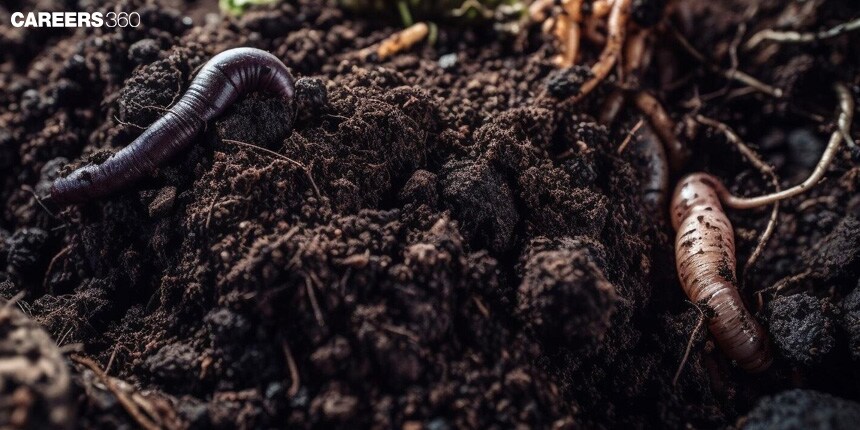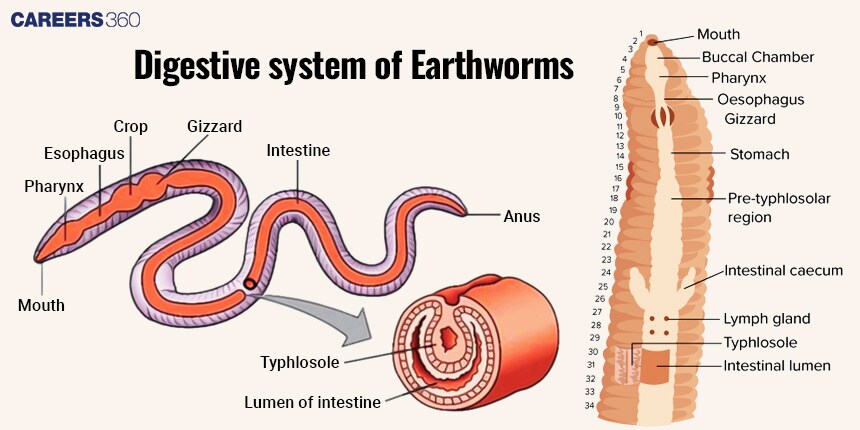Digestive system of Earthworms: Definition, Characteristics, Classification, Examples, Structure
Earthworms are considered major belowground ecosystem engineers. Activities carried out by earthworms encompass a very wide significance towards soil health and fertility due to the burrowing and decomposition of organic matter. The alimentary canal of an earthworm is the organ through which earthworms process and re-mineralise nutrients in the soil, further enhancing the texture to provide a conducive environment for plants to grow in.
This Story also Contains
- Anatomy Of Earthworms
- Digestive System Overview Of Earthworms
- Importance Of Earthworms In Ecosystems
- The Recommended Video On The Digestive System Of Earthworm:

Anatomy Of Earthworms
- An earthworm's body is segmented and contains distinct regions: the head, anterior, segments, clitellum, and tail posterior.
Each segment consists of setae, small, bristle-like structures that help in movement and anchoring to the soil.
The body wall is lined with epidermis and circular and longitudinal muscles that line up to help in locomotion by peristalsis.
It is a fluid-filled cavity found in each segment, endowing it with a hydrostatic skeleton useful for movements and space for organ development and functions.
Digestive System Overview Of Earthworms
The anterior end has a mouth that ingests soil and organic matter. Then comes the muscular pharynx, which plays the role of sucking up food. The pharynx produces mucus and enzymes, which help break the food a little.
The oesophagus acts like a passage that takes food from the pharynx and passes it into the crop. The oesophagus produces calcium carbonate to neutralise the acidity of the ingested materials.
The crop is that organ which performs the function of a storage unit for food and hence it regulates the intake of food into the gizzard.
The gizzard is filled with small stones and grit that the earthworm ingests; these organs have thick, strong muscles that pulverise food particles, breaking them down mechanically.
The chief site of digestion and absorption is in the intestine. It has a specialised region with typhlosole, which is a way of unfolding that increases surface area for more efficient nutrient absorption. The intestinal walls secrete enzymes that further break down food particles.
Diagram Of Earthworm’s Digestive System
The diagram given below shows the internal structure of the earthworm body corresponding to segments.

Digestive Processes
The digestive juices of the pharyngeal glands contain enzymes like amylases and proteases that initiate the digestion of carbohydrates and proteins, respectively.
Food is mechanically digested in the gizzard and chemically digested in the intestine. Enzymes break down complex molecules into simpler absorbable ones.
Nutrient absorption takes place through the wall of the intestine into the bloodstream. It is distributed to other parts of the body, mainly for providing energy, supporting growth, and helping tissues to repair themselves.
Adaptations For Digestion
Gut bacteria in earthworms help in breaking down cellulose and other complex organic compounds. Again, in this mutualistic relationship, the earthworm's digestion rate and nutrient absorption are further improved.
Several adaptations have evolved in this earthworm, such as its extensively long, coiled intestine with the typhlosole, which enhances the efficiency of extracting nutrients from the ingested organic material. This efficiency therefore supports their role in soil fertility by breaking down organic matter into humus and releasing essential nutrients into the soil.
Importance Of Earthworms In Ecosystems
As ecosystem engineers, earthworms fundamentally alter explicitly their soil structure and incidentally the cycling of nutrients. Burrowing loosens the soil, hence improving water infiltration and root penetration. Digestion and excretion in earthworms deal with organic matter, producing casts that may confer the nutrient-rich status on soils and improve their structural properties.
Conclusion
The digestive system is central to the earthworm's role in soil ecosystems. Digestion by the earthworms breaks organic material and recycles the nutrients, hence improving soil health and fertility. Plants grow well; the balance needed in the ecology is maintained. The study of earthworms gives insight into finding sustainable soil management practices for the overall health of terrestrial ecosystems.
The Recommended Video On The Digestive System Of Earthworm:
Frequently Asked Questions (FAQs)
Earthworms consume soil, decaying organic matter, and microorganisms.
Earthworms increase the fertility of the soil by aerating the soil, giving way to good water infiltration, and increasing it with their nutrient-rich casts after digestion and excretion.
Even with the differences in specific structure and operation, many of the systems involve the processes of ingestion, mechanical and chemical digestion, nutrient absorption, and defecation.
An earthworm's digestive system grinds soil and organic matter in the gizzard and further digests it in the intestine, where nutrients will be assimilated and the waste expelled.
The main parts include the mouth, pharynx, oesophagus, crop, gizzard, and intestine.